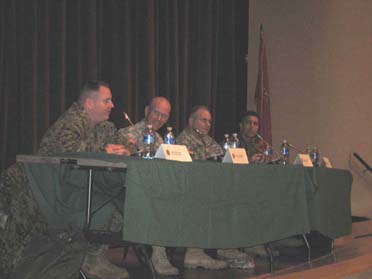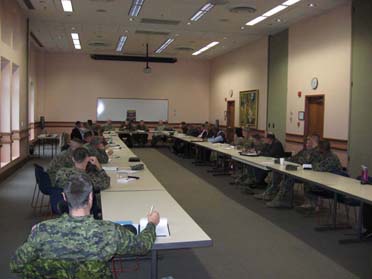Great conversation on complex issues led into today's seminar -- adding into the mix an informed and experienced audience made for quite a day. We will have more on this later as we sort through the notes for an AAR and format the video of today's panel discussion as well as the Q&A for CD and web posting.
With that, I'll leave you with a couple of pics and the opening remarks of LTC Paul Yingling.


COIN Leadership Conference Opening Remarks By LTC Paul Yingling:
First, I'd like to thank the USMC Center for Irregular Warfare's Colonel Dan Kelly and JFCOM Irregular Warfare Center and Small Wars Journal's Dave Dilegge for coordinating this event, and note what an honor it is to appear today with Colonel Dave Maxwell and Colonel Steve Davis. I'd like to ask by a show of hand how many of you have been deployed on at least one combat tour. Two? Three or more? I'm honored to be here with you today; thank you all for your service.
I'll keep my comments short; given your experiences, your questions and comments will be far better than my responses. Today I'd like to open a dialogue with you about adaptive leadership. I'm mid-way through my third tour in Iraq. Each time I return, I'm struck by how much our combat forces have adapted to the challenges of warfare in the 21st century. In 2003, I was involved in raising a battalion of the Iraqi Civil Defense Corps, a poorly trained, poorly equipped force that deserted upon first contact with the enemy. In 2005, I served with the 3d Armored Cavalry Regiment in Tall Afar, as part of the first large-scale application of the clear-hold-build strategy that would later become a cornerstone of our counterinsurgency doctrine. In 2008, I serve with Task Force 134, applying the practices of counterinsurgency operations inside the wire -- emphasize intelligence, provide security and essential services to the population, isolate extremists, enable the rehabilitation and reintegration of those —to support the government, and build host nation capabilities to provide security under the rule of law. My experiences are in no way unique; every multiple tour veteran I meet has similar accounts of adaptation under fire.
Every time I return to the United States, I'm struck by how little the institutional military has adapted to the challenges of the wars we're fighting. I've spent the last seven years in conventional Army tactical units; it might be that I'm missing something going on in other services, the special operations community, or even in other parts of the Army. However, from my perspective much remains the same. Our system of senior officer development remains essentially unchanged since the Cold War -- the same system that produced the officers who for the last generation failed to prepare for irregular warfare. Our force structure has changed only modestly from the pre-911 era -- and still lacks sufficient intelligence, civil affairs, special operations, military police, linguist, and security force development capabilities necessary for irregular warfare. Our procurement priorities have deviated incrementally from their pre-911 patterns only after the Secretary of Defense publicly pleaded with the services to 'fight the wars we're in." After nearly four years of conducting counterinsurgency operations, the Army and Marine Corps published a counterinsurgency doctrine, and a pretty good one at that. While these modest changes are welcome, they pale in comparison to the rate of adaptation of combat forces.
Why is the institutional military so much less adaptive than combat forces in the field? It's not the people -- service members routinely rotate between the institutional military and the operating forces in the field. Instead, I believe it's the incentive system, and it's that system I'd like to discuss with you today.
Combat forces operate under a simple, brutal incentive system -- adapt or die. Forces in combat are not by virtue of their location intellectually or morally superior to their counterparts in the institutional military. Rather, their priorities are clearer -- when the failure to adapt carries a death sentence, every other consideration -- service and branch loyalties, core competencies, organizational cultures -- pales in comparison.
The institutional military operates under a different incentive system. Those responsible for acquisition operate under powerful incentives to procure expensive, high-tech weapons, even if those weapons are not the ones combat forces need. Those responsible for force structure design operate under powerful incentives to defend existing organizations from claims by other branches and services, even if the existing force structure does not meet the needs of combatant commanders. Finally and most importantly, military officers operate under powerful incentives to conform to senior officers' views, even if those views are out of touch with battlefield realities. Unlike combat forces, the institutional military operates under an incentive system that rewards conformity and discourages adaptation. These are good people, but they work in a bad system. It's simply not reasonable to expect that large groups of people over long periods will behave in ways contrary to the incentives under which they operate.
Having described the problem, I'll conclude with some proposed solutions that I hope will generate further questions and comments in our discussion:
First, our Armed Forces are incapable of internal reform on the scale necessary to prepare for the wars of the 21st century. Such reform will require political intervention; preferably by Congress, as statutory reforms are far more durable than executive ones.
Second, the most urgently needed reform lies in our system for developing senior officers. A few high-profile exceptions notwithstanding, our system for developing senior military officers rewards conformity, suppresses innovation advances parochial interests at the expense of the public good.
Third, we must institutionalize adaptation; we cannot rely solely on battlefield experience to drive innovation. We must replace our insular, top-down Cold War organizational culture with one that learns from the bottom up and the outside in. As current conflicts recede into memory, our hard-won adaptations may be lost in a rush to 'reset' and return to so-called 'core competencies.'
Fourth, we must speed the pace at which we learn and adapt. We've lost thousands of lives and spent hundreds of billions of dollars in the last seven years in our ongoing efforts to bring stability to two medium sized countries; we can't afford to adapt this slowly in the future.
Fifth and finally, junior leaders cannot wait on institutional change to build adaptive leaders. Leaders at the battalion level and below can take action right now to build the leaders we need for the wars of the 21st century. These actions include 360-degree counseling and evaluations, professional development programs focusing on unstructured problem solving, multi-player, free play tactical exercises, and all-ranks combatives.
I've written about these reforms in professional journals and implemented these leader development practices in my battalion; I look forward to discussing them further today. I recognize that my views are controversial; I appreciate your patience in hearing me out and look forward to your questions and comments. Thank you.
